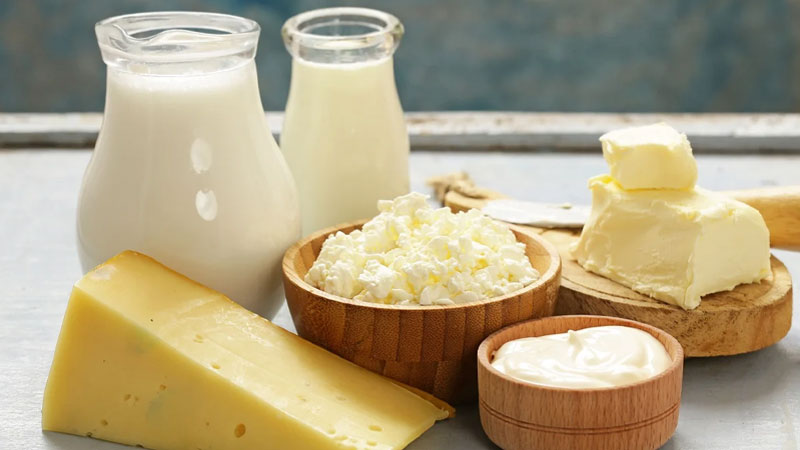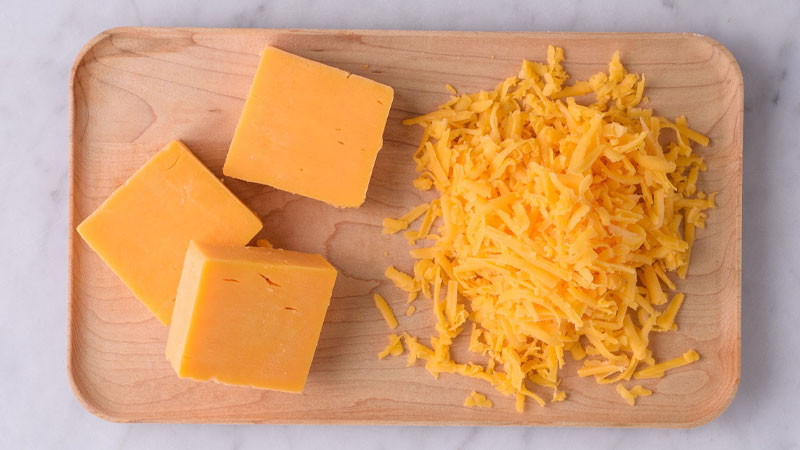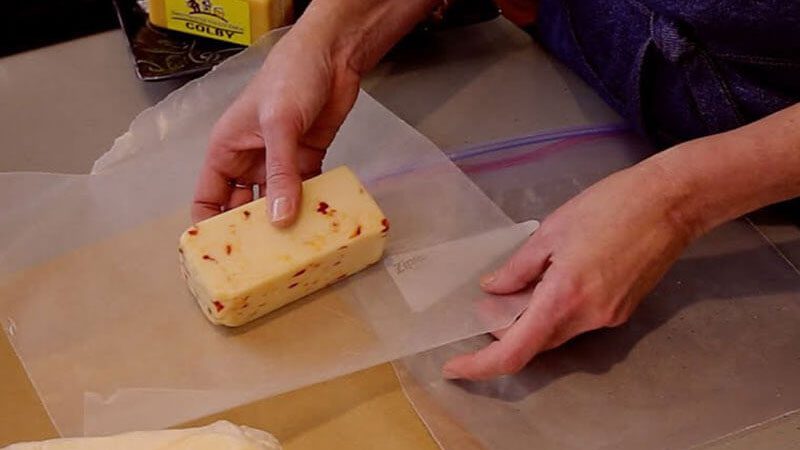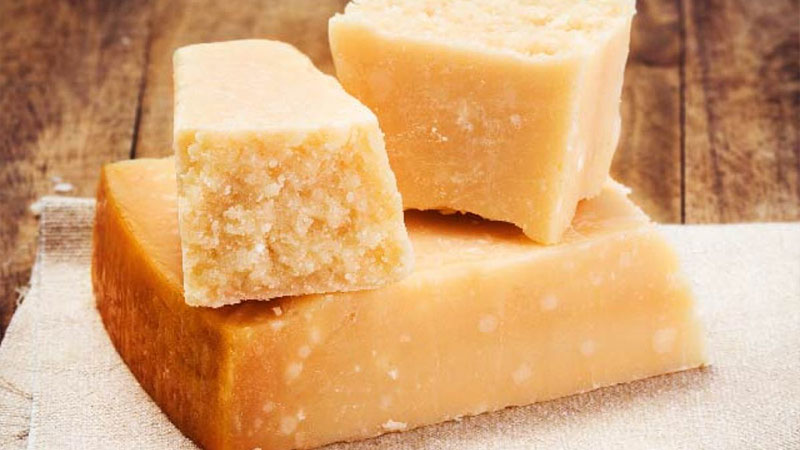Cheese is a nutritious food, rich in protein and minerals that are good for the body and recommended by experts. But did you know the nutritional value and health benefits of cheese? How many types of cheese are there, and how are they made and stored? In this article, we will answer these questions and more, so read on to learn everything you need to know about cheese!
1 What is Cheese?
Nutritional Value of Cheese
Cheese is a popular dairy product made from the curdling and fermentation of milk from cows, goats, sheep, or other mammals.
 Cheese is a popular dairy product made from milk
Cheese is a popular dairy product made from milk
Cheese is known for its high nutritional content, providing a good amount of calcium, protein, vitamins, and minerals to our bodies.
According to studies, one ounce of hard cheese, or a small piece about the size of your thumb, contains approximately 120 calories, 8g of protein, 6g of fat, and 180mg of calcium. Similarly, half a cup of soft cheese, such as 4% pure fat cream cheese, contains around 120 calories, 14g of fat, 3g of saturated fat, and 80mg of calcium.
 Cheese is a nutritious food
Cheese is a nutritious food
Additionally, most types of cheese contain high amounts of sodium, ranging from 300-450 mg per serving. This is because salt helps retain moisture and prevents the overgrowth of bacteria.
Health Benefits of Cheese
Reduces Stress
Research has shown that cheese contains tryptophan, an essential amino acid that helps produce serotonin. This regulates and balances your mood and reduces anxiety and stress.
Promotes Healthy Bones and Teeth
Cheese is rich in calcium, phosphorus, and minerals like zinc, vitamin A, and vitamin B12, among others. These nutrients contribute to the protection and maintenance of strong bones and teeth and help prevent osteoporosis in older adults.
 Cheese promotes healthy bones and teeth
Cheese promotes healthy bones and teeth
Reduces Risk of Stroke
A study published in the Journal of Food and Nutrition Research suggests that consuming cheese can help lower the risk of cardiovascular diseases and control blood pressure. Additionally, cheese contains acids that prevent artery blockages, which can lead to strokes.
Improves Digestive Health
Cheese is a fermented food that promotes the growth of beneficial gut bacteria, improving digestion and enhancing nutrient absorption.
 Cheese improves digestive health
Cheese improves digestive health
Provides High-Quality Protein
In addition to calcium and fat, cheese is also a rich source of protein, which is essential for the growth and development of children. Protein provides energy and supports the healthy development of muscles and bones.
2 Types of Cheese and How to Distinguish Them
Mozzarella Cheese

Made from water buffalo or cow’s milk, mozzarella is commonly used in pizzas, cheese sticks, and grilled sandwiches. When melted, it becomes stretchy and forms long strings. Due to its high moisture content, fresh mozzarella can be stored in the refrigerator for about a week. Drier, pre-shredded mozzarella can last up to six weeks.
Mozzarella is a versatile cheese that can be added to soups, paired with fruits, or used in dishes like pepperoni pizza, bolognese lasagna, and eggplant parmesan.
Cream Cheese

Also known as cream cheese, this is a fresh cheese made from cow’s or goat’s milk. It has a white to pale yellow color, a soft texture, and a mildly salty and tangy flavor. Its versatility and lack of overwhelming richness make it a popular choice.
Cream cheese is often used by chefs in desserts like cheese soufflés and cheesecakes or as a spread on bagels, carrot cakes, and other baked goods. It can also be used to decorate the surfaces of beverages and sweet treats.
Cheddar

Cheddar has a pale yellow to white color and a slightly firm texture. It is commonly used in baked dishes like pizzas, casseroles, and savory pastries, or as a topping for hamburgers and sandwiches.
To produce high-quality cheddar, the cheese must be aged for 9-24 months to develop its distinctive yellow color and reach its optimal flavor.
You can enjoy sliced cheddar on its own or add it to dishes like omelets, quiches, pasta bakes, and casseroles.
Mascarpone

Mascarpone is a fresh cheese made from cow’s milk by adding acidic ingredients like lemon juice, citric acid, or acetic acid during the cream separation process.
Mascarpone is soft and creamy with a white color. It can be eaten straight as a dessert topping, fruit dip, or cheesecake base without baking. It’s also great in soups, sauces, and other savory dishes.
Ricotta

Originating in Italy, ricotta cheese is a fresh, mild-flavored cheese that is less rich and fatty than many other types of cheese.
You can easily make ricotta cheese at home using whole milk, heavy cream, buttermilk, and lemon juice. Let it sit overnight to curdle and form a rich, creamy cheese that pairs well with fruits, crackers, or used as a topping for pasta dishes.
Emmental

Made from cow’s milk, Emmental has a pale yellow color, a mildly tangy flavor, and a slightly soft and stretchy texture. It melts easily and is commonly found in thin square slices for hamburgers and sandwiches.
Blue Cheese

Blue cheese is characterized by its blue, blue-gray, or blue-green veins running through the cheese. It pairs well with fruits, crackers, or a glass of wine.
Brie Cheese

The quality of Brie cheese depends on the source of milk and its production. It has a strong aroma and a creamy texture when ripe and can be eaten on its own or paired with fruits or bread.
Edam Cheese

Edam cheese, named after the Dutch town of Edam, is recognizable by its spherical or cylindrical shape and red paraffin wax coating. It has a pale yellow interior and is easy to slice and melt, making it a popular topping for sandwiches and burgers.
Parmesan Cheese

Parmesan cheese, or Parmigiano-Reggiano, is produced mainly in the Italian provinces of Parma, Reggio Emilia, Bologna, Modena, and Mantua. As a result, it is a common ingredient in Italian dishes like pasta and risotto.
Parmesan is a hard cheese made from cow’s milk and aged for at least a year, often between two and three years, to reach its optimal flavor. When eating, it is typically grated, shredded, sliced, or chopped. For the best flavor, choose a block of Parmesan over pre-grated varieties.
For Fresh Cheese
Fresh cheese should be packaged in airtight containers or vacuum-sealed bags and stored in the refrigerator to minimize air exposure. This method can keep the cheese fresh for 4-10 days.
 Package fresh cheese in airtight containers or vacuum-sealed bags
Package fresh cheese in airtight containers or vacuum-sealed bags
For Hard and Semi-Hard Cheese
Hard and semi-hard cheeses should be wrapped tightly in specialized cheese paper or wax paper to prevent moisture loss and sealed with tape or elastic bands to avoid air exposure. The ideal storage temperature for these cheeses is around 6°C (43°F).
 Wrap hard and semi-hard cheeses tightly in specialized cheese paper or wax paper
Wrap hard and semi-hard cheeses tightly in specialized cheese paper or wax paper
4 Frequently Asked Questions about Cheese
How Many Calories Are in Cheese? Is It Fattening?
Typically, 100g of cheese contains approximately 402 calories, although this can vary depending on the type of cheese. For example, 15g of Laughing Cow cheese has about 67 calories, while 100g of mozzarella contains around 280 calories.
In moderation, a small piece of cheese (about 15g) won’t significantly impact your daily calorie intake or weight. However, in reality, many people don’t pay attention to portion sizes, and overeating cheese can lead to excess calorie consumption and weight gain.
 100g of
100g of



































